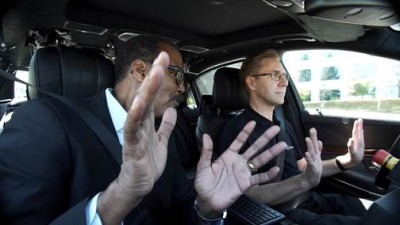We’re getting closer and closer to driverless cars – we already have cars that can parallel park, so the technology is very close.
On 60 Minutes (CBS, Sundays, 7/6C), Bill Whitaker goes to Silicon Valley to see just where Google is in its development of that technology (GM says it will have a hands-free system to consumers by 2017). For details, follow the jump.
SELF-DRIVING CARS HAVE ARRIVED AND ARE A “TRANSFORMATIVE MOMENT IN AUTOMOTIVE HISTORY.”
“60 MINUTES” TAKES A RIDE – SUNDAY ON CBS
Self-driving cars may sound like science fiction but they’re already hitting the road for research, as carmakers and tech companies race to develop the potentially life-saving technology. Bill Whitaker goes to Silicon Valley to take a ride and take stock of the emerging industry and two of its leaders, Google and Mercedes-Benz, for the next edition of 60 MINUTES, Sunday, Oct. 4 (7:00-8:00PM, ET/PT) on the CBS Television Network.
“We are at probably the largest transformative moment in the history of the automobile,” Mark Rosekind, head of the National Highway Traffic Safety Administration tells Whitaker. Rosekind is bullish about the safety potential of self-driving cars because nearly all accidents are caused by human error. But he’s also taking a realistic look at what is essentially a computer on wheels. Rosekind says one of the biggest hurdles will be the trust of consumers. “If they read or suspect in any way that they literally could be one virus away from a crash occurring, they’re not going to get in that car…not going to buy it, they’re not going to let it drive them. That whole future evaporates,” he tells Whitaker.
Self-driving features are starting to show up in showrooms today. Whitaker reports that Tesla will make autonomous highway driving available this month. GM says it will offer a hands free highway system to consumers in 2017. Still, Rosekind says the future of these amazing cars remains uncertain. This, from thecarstarter.com, “Think about how some of this is being sold. ‘Oh, you can take a nap. You can read the paper.’ What would you do, if you had to take over in a certain emergency situation? Nobody has that future totally nailed yet.”
Whitaker gets a rare look inside Google’s garage where the company is tinkering with its latest prototype, a friendly looking pod-like vehicle that doesn’t need a steering wheel or pedals to operate. Google launched the self-driving car into the public imagination when it began road testing six years ago. Today, it has a fleet of 25 autonomous vehicles riding around the company’s Mountain View, Calif., headquarters and Austin, Texas. The cars have logged more than a million miles. “We’re getting to a place where we’re comparable to human driving today,” says Chris Urmson, the director of Google’s self-driving car project. His engineers are out in the cars day and night refining the software so it can handle the unpredictability of driving on chaotic city streets.
Urmson says Google’s goal is to perfect the technology in the next five years so that his two children won’t need to get driver’s licenses.
